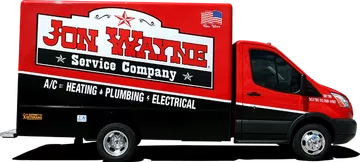What Is Freon?

“Freon” is a word you might have heard when talking about air conditioners, but what is Freon, actually? In short, Freon is a brand of refrigerant that has been crucial in cooling systems for many years.
Whether you’re just curious about how your air conditioner keeps you cool, or you’re concerned about the environmental effects, this post will provide you with a straightforward understanding of Freon. Keep reading to learn more about:
- What Freon Is
- How Freon Works in Your Air Conditioning System
- Why Freon Has Been at the Center of Environmental Discussions
- The Phase-Out of Freon: What Comes Next?
You can also check out our blog, “Air Conditioner History & Other Interesting Facts,” to read more about the history of cooling systems.
Have questions about Freon? Get expert answers from Jon Wayne's trusted professionals.
Concerned that your air conditioning might be using outdated Freon? Contact Jon Wayne’s expert HVAC professionals for trustworthy advice. Whether you need to retrofit or install a new cooling system, we’ll provide you with honest, cost-effective advice and ensure your home stays safe and comfortable. New installation estimates are free, and we offer convenient financing options and help sourcing HVAC rebates.
What Is Freon?
The word “Freon” is used interchangeably with “refrigerant,” but Freon is actually a registered trademark of The Chemours Company, one of the original brands of refrigerant. Developed in the 1930s, Freon revolutionized the refrigeration and air conditioning industries by providing safer and more reliable alternatives to previously used toxic or flammable substances.
Types of Freon
The term "Freon" has been applied to a range of refrigerants over the years, with the most common types being:
- R-12: A CFC refrigerant, once commonly used in car air conditioning systems but phased out due to its ozone-depleting properties.
- R-22: An HCFC, known as HCFC-22, which has been widely used in residential heat pumps and air conditioning systems. It is less damaging to the ozone layer than R-12 but still has significant environmental impacts.
- R-134a: A hydrofluorocarbon (HFC) that does not deplete the ozone layer, used in many automotive air conditioning systems as well as in commercial refrigeration.
Each type of Freon has distinct chemical properties and uses, but all work on the same basic principle of absorbing heat when changing from a liquid to a gas and releasing heat when returning from a gas back to a liquid.
How Freon Works in Your Air Conditioning System
Freon is used as a refrigerant in AC systems, cycling through a closed loop of evaporation and condensation. The compressor first compacts Freon into a high-pressure gas, which travels to the condenser, where it releases absorbed heat and condenses into a cool liquid. This cool liquid flows through the expansion valve, then expands rapidly and cools further to become a low-pressure cold vapor while entering the evaporator.
Once inside the evaporator, Freon captures heat from interior air that blows over the fan coil, cooling the air and letting refrigerant evaporate back into vapor. This vapor returns to the compressor to repeat the cycle, creating a cooler indoor climate and releasing heat outside.
Why Freon Has Been at the Center of Environmental Discussions
Although Freon has been a popular choice in air conditioning systems, it poses significant environmental risks, particularly older types such as R-22. These refrigerants are notorious for depleting the ozone layer and contributing to global warming. In response to these detrimental effects, regulatory measures have become increasingly stringent over the years to curb the use of such harmful substances.
Internationally, the Montreal Protocol is a crucial treaty established to protect the ozone layer by phasing out the production of substances that cause ozone depletion, including both CFCs and HCFCs. Similarly, in the United States, various laws have been enacted to phase out ozone-depleting substances (ODS). Notably, by January 1, 2020, the production and import of R-22 Freon were officially banned, marking a significant step in environmental protection efforts.
The Phaseout of Freon: What Comes Next?
If you're concerned about the regulatory phaseout of R-22, first, identify if your cooling system uses the refrigerant by looking at its label or documentation. Look for signs your unit may be running low on the refrigerant, such as reduced cooling and higher energy bills.
These signs may indicate you need to recharge your refrigerant, which can get expensive — or even impossible — if your unit uses R-22. This job requires special tools, expertise and regulatory knowledge to legally manage refrigerant replacements. AC specialists like Jon Wayne can help by recharging your unit for optimal performance or letting you know if you need a replacement.
As the AC industry continues to move away from traditional R-22, new units and systems typically use next-generation coolants like R-410A instead. Offering significant advantages over R-22, these refrigerants improve energy efficiency and have a much lower ozone depletion potential.
Not sure what type of refrigerant your AC has?
As San Antonio’s local 5-star rated HVAC pros, Jon Wayne is here to provide clear, trustworthy assessments of your AC system. Let our highly-trained and experienced technicians inspect your unit and give you honest answers about its compliance with current standards. All new AC estimates are FREE, and we can even help you apply for HVAC rebates to reduce your upfront investment. Contact us today!

